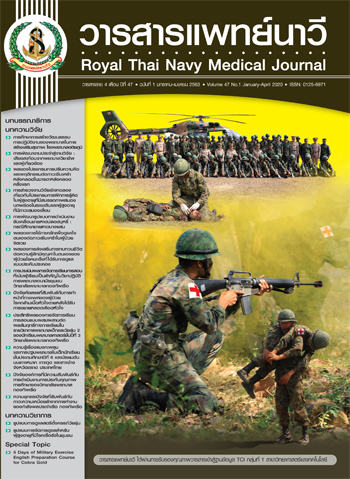ความชุกและปัจจัยที่สัมพันธ์กับภาวะความเหนื่อยล้าจากการทำงานของกำลังพลประจำเรือ กองทัพเรือ
Main Article Content
บทคัดย่อ
การวิจัยครั้งนี้มีวัตถุประสงค์เพื่อศึกษาความชุกและปัจจัยที่สัมพันธ์กับภาวะความเหนื่อยล้าจากการทำงานของกำลังพลประจำเรือ กองทัพเรือ กลุ่มตัวอย่าง ได้แก่ กำลังพลประจำเรือ สังกัดกองเรือยุทธการ กองทัพเรือ ที่ปฏิบัติงานในพื้นที่ ณ ฐานทัพเรือสัตหีบ ทัพเรือภาคที่ 1 จังหวัดชลบุรี จำนวน 424 ราย มีเกณฑ์คัดเข้า คือ เพศชาย อายุตั้งแต่ 18 ปีขึ้นไป เป็นกำลังพลประจำเรือ กองทัพเรือ ที่ไม่ใช่หมู่ฝึกนักเรียนนายเรือ และไม่ใช่กำลังพลประจำเรือที่ออกราชการสมทบชั่วคราว เครื่องมือที่ใช้ในการวิจัยเป็นแบบสอบถามข้อมูลส่วนบุคคล ข้อมูลด้านการแพทย์และพฤติกรรมสุขภาพ ข้อมูลด้านการทำงานและลักษณะงาน และแบบวัดภาวะความเหนื่อยล้าจากการทำงานของแมสแลช (Maslach burnout inventory) ฉบับภาษาไทย ซึ่งผ่านการตรวจสอบความตรงตามเนื้อหาจากผู้ทรงคุณวุฒิ จำนวน 3 ท่าน และทดสอบความเที่ยงโดยคำนวณหาค่าสัมประสิทธิ์แอลฟาครอนบาค ได้เท่ากับ 0.87 วิเคราะห์ข้อมูลด้วยสถิติ การวิเคราะห์การถดถอยพหุโลจิสติก เพื่อศึกษาปัจจัยที่มีความสัมพันธ์กับภาวะความเหนื่อยล้าจากการทำงาน และนำเสนอข้อมูลด้วย ความถี่ ร้อยละ Odds ratio (OR) และกำหนดค่าความเชื่อมั่นร้อยละ 95
ผลการวิจัย พบว่า ความชุกของภาวะความเหนื่อยล้าจากการทำงานของกำลังพลประจำเรือ กองทัพเรือ เท่ากับร้อยละ 22.4 โดยแบ่งเป็นด้านความอ่อนล้าทางอารมณ์ ร้อยละ 13.1 ด้านการลดค่าความเป็นบุคคล ร้อยละ 23.9 และด้านความรู้สึกตนเองมีความสำเร็จลดลง ร้อยละ 70.4 โดยปัจจัยที่มี
ความสัมพันธ์กับภาวะความเหนื่อยล้าจากการทำงานของกำลังพลประจำเรือ กองทัพเรือ ในภาพรวม อย่างมีนัยสำคัญทางสถิติที่ระดับ .05 มี 6 ปัจจัย ได้แก่ ช่วงอายุ วุฒิการศึกษา ระดับชั้นยศ ปฏิสัมพันธ์กับเพื่อนร่วมงาน การได้รับการสนับสนุนจากหน่วยงาน/องค์กร และการมีความคิดอยากลาออกจากการเป็นกำลังพลประจำเรือ กองทัพเรือ
โดยสรุป กำลังพลประจำเรือ กองทัพเรือ มีความเสี่ยงต่อการเกิดภาวะความเหนื่อยล้าจากการทำงาน โดยเฉพาะกำลังพลที่มีอายุน้อยและระดับชั้นยศน้อย ดังนั้นจึงควรมีการเฝ้าระวังป้องกันและตรวจคัดกรองสุขภาพ รวมถึงการสร้างเสริมปฏิสัมพันธ์กับเพื่อนร่วมงาน การสนับสนุนด้านต่างๆ เพื่อลดโอกาสการเกิดภาวะความเหนื่อยล้าจากการทำงานของกำลังพลประจำเรือ กองทัพเรือ
Article Details

อนุญาตภายใต้เงื่อนไข Creative Commons Attribution-NonCommercial-NoDerivatives 4.0 International License.
เอกสารอ้างอิง
Ninsanguandecha S, Buathong N. Job burnout and problem coping strategies among employees of Government Pharmaceutical Organization. Chula Med J 2016;60(5):545-60. (in Thai).
Mealer M, Moss M, Good V, Gozal D, Kleinpell R, Sessler C. What is burnout syndrome (BOS)?. Am J Respir Crit Care Med 2016;194:1-2.
Pines AM, Keinan G. Stress and burnout: the significant difference. Personality and Individual Differences 2005;39(3):625-35.
Institute for Quality and Efficiency in Health Care (IQWiG). Depression: what is burnout? [Internet]. [cited 2017 January 12]. Available from: https://www.ncbi.nlm.nih.gov/
books/NBK279286/.
Oldenburg M, Jensen HJ, Wegner R. Burnout syndrome in seafarers in the merchant marine service. Int Arch Occup Environ Health 2013;86(4):407-16.
Bakker AB, Costa PL. Chronic job burnout and daily functioning: a theoretical analysis. Burnout Research 2014;1(3):112-9.
Carotenuto A, Molino I, Fasanaro AM, Amenta F. Psychological stress in seafarers: a review. Int Marit Health 2012;63(4):188-94.
Chung Y-S, Lee PT-W, Lee J-K. Burnout in seafarers: its antecedents and effects on incidents at sea. Maritime Policy & Management 2017;44(7):916-31.
Patchiappane M, Rengamani J. A study on the job satisfaction and job burn out of Indian marine engineers. International Journal of Civil Engineering and Technology 2017;8(11):427-36.
Rengamani J, Shameem A. A study on the factors influencing the occupational stress of Indian seafarers. International Journal of Mechanical Engineering and Technology 2017;8(6):411-7.
Mellbye A, Carter T. Seafarers' depression and suicide. Int Marit Health 2017;68(2):108-14.
Håvold JI. Stress on the bridge of offshore vessels: examples from the North Sea. Safety Science 2015;71(PB):160-6.
Thai Civil Rights and Investigative Journalism. Camouflage scanning: stress-depression after shocking of soldiers at the Southern Border. [Internet]. [cited 2017 January 12]. Available from: https://www.tcijthai.com/news/2015/12/scoop/5677. (in Thai).
Drug Addict Treatment and Rehabilitation Unit, Naval Medical Department. A guide to prevention and solving drug problems in Royal Thai Navy. Samut Prakan: 2 Twin Printing; 2018. p. 194-250. (in Thai).
Kaewkungwan J, Singhasivanon P. Sample sizes of clinical research. In: Pitisutthitham P, Picheansoonthon C, editors. Textbook of clinical research. Bangkok: Faculty of Tropical Medicine, Mahidol University; 2011. (in Thai).
Summawart S. Burnout among the staff nurses in Ramathibodi Hospital. [Master's Thesis, Faculty of Medicine Ramathibodi Hospital]. Mahidol University; 1989. (in Thai).
The Psychaiatric Association of Thailand. “Burnout”. [Internet]. [cited 2017 January 12]. Available from: https://thaipsychiatry.wordpress.com/2014/05/17/%E0%B8%AB%
E0%B8%A1%E0%B8%94%E0%B9%84%E0%B8%9F-burnout/. (in Thai).
Agterberg G, Passchier J. Stress among seamen. Psychol Rep 1998;83(2):708-10.
Leelukkanaveera Y, Longphimai C, Toonsiri C. Influencing factors of stress among the Royal Thai Navy in Narathiwat Province. Royal Thai Navy Medical Journal 2018;45 (2):399-416. (in Thai).
Junbumrung Y. Factors in work operation having connection with employee' stress, case study: Bangkok Glass CO., LTD. [Independent Study]. Intellectual Repository of Rajamangala University of Technology Tanyaburi: Rajamangala University of Technology Tanyaburi; 2012. (in Thai).
Shi LC, Dai JJ, Wang HR, Wang JL, Miao LQ, Yang LR. Current status of job burnout in in-service sailors from 13 provinces and cities in China. Zhonghua Lao Dong Wei Sheng Zhi Ye Bing Za Zhi 2017;35(12):893-7.
Puangsorn P, Buathong N. Mental health and defense mechanism among flight attendants in a commercial airline in Thailand. Chula Med Journal 2017;61(6):799-813. (in Thai).
Woodhead EL, Northrop L, Edelstein B. Stress, social support, and burnout among long-term care nursing staff. J Appl Gerontol 2016;35(1):84-105.
Eamsamai C. A study of the Royal Thai Navy explosive ordnance disposal personnel stress. [Master's Thesis, Faculty of Public and Private Management]. Burapha University; 2014. (in Thai).


